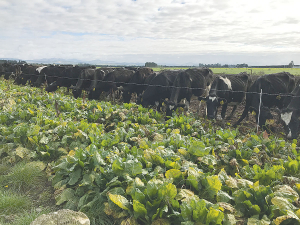DairyNZ talked to two Canterbury dairy farmers about how they look after their cows and the environment during the challenging winter.
Rain and cold make winter the worst of challenges – wet underfoot and hard on humans and animals.
Caring for dairy cows and managing mud then becomes a key priority for all farmers grazing cows.
As Ashburton dairy farmer Mark Slee pulls his truck up alongside one of his paddocks, his cows wander over to see what he’s up to.
They’re full and content, with bright eyes and glossy coats, but they’re curious to see if he’s got something for them.
But Slee and his wife Devon, like most dairy farmers, are prepared. They’ve spent the last year growing extra feed and planning how best to manage their paddocks.
In the South Island, most dairy farmers feed out fodder beet, kale and swede to keep their cows in best condition when grass is scarce. But when the crops are eaten the soil is left bare and at risk of turning into mud if not managed carefully.
Slee outlines techniques for keeping mud to a minimum to ensure their cows can move freely, have a dry surface to lie down and reduce the impact on the environment. These include back fencing, portable troughs and extra feed such as hay or baleage.
“We love our cows, they’re our biggest asset, so looking after them is a top priority for us no matter what season,” he says.
Regular monitoring
Slee, who feeds swede, kale and fodder beet over winter, regularly checks that his cows have enough feed and are content, and that the condition of paddocks is acceptable.
During DairyNZ’s visit, Slee is moving some of his rising two-year-old bulls onto swede and he checks on them in the afternoon. He cracks open a swede and takes a few bites. It’s ok.
On crops, the cows can eat their required nutrients in three to four hours, he says. The crops’ nutrient levels are such that each day he need spend only a short time supplementing the cows’ feed with hay or baleage to keep them full and warm and to ensure a balanced diet.
While cows are “pretty resilient” and grow “thick winter coats”, in very bad weather Slee moves them to sheltered paddocks and offers extra straw to increase their comfort.
“But the best thing is keeping conditions underfoot as dry as possible so they have somewhere to lie down and they get extra feed.”
Feeding on fodder beet
Meanwhile, on Glenn and Sarah Jones’ dairy farm one hour away at Hororata, the cows perk up with the daily allocation of fodder beet.
When farm assistant Beccy Cochrane brings them in from their pasture, they clear the gate into the fodder beet paddock then break into a jog to a spot in front of the break fence.
Once they’re lined up, all you can hear is the sound of contented munching. Within half an hour they’ve devoured the lot. “It’s like sugar to them, they love it,” says Jones.
They’re now being fed only a small amount as they’re transitioning onto crop and getting used to the rich feed. This takes a few weeks.
But planning for winter started at least 12 months ago.
The crop, sown in November, provides 25tDM/ha feed for the winter months. And Jones has extra grazing at a nearby property.
Minimising mud
Jones says minimising mud is a big focus for animal welfare and environmental reasons.
“Winter is a real challenge, particularly with fodder beet when you’re feeding a smaller area because of the high yield per hectare. When conditions get wet we move the break fence more frequently, three to four times a day, so the cows can eat under the wire to fully use the feed, and we use back fences and portable troughs so they’re not walking back and forth across the paddock.”
In severe rain or snow they move the cows off crops and onto a grass paddock to minimise damage to soil and provide more shelter.
“Cows walking through mud all day takes a lot of energy out of them. It’s not good for them and it’s not something we like to see so we try to minimise it.”
An online video depicts Slee and Jones explaining more about their winter farming.
www.dairynz.co.nz/wintering
• This article first appeared on DairyNZ’s website and has been reproduced with permission.


















